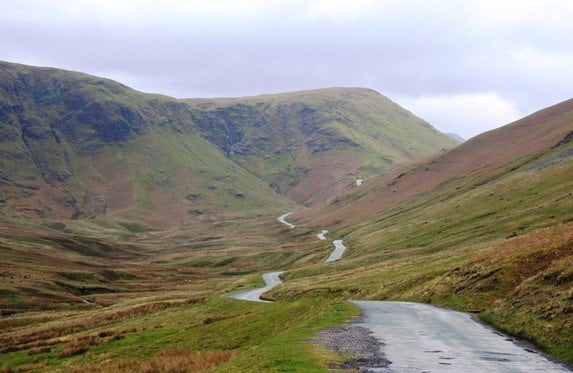
Walking along some fellside path in the Lake District, grey skies and a gentle drizzle, suddenly I am able to fly upwards. Hovering high above the hills, fields and waters, I can see the lattice-work of tracks, paths and roads that intersect across the land. With this map-like view of the terrain I view across all time periods as well. Each route reveals a continuous line of people, from ancient times to present times, from hunters to backpackers, each treading along the same routes, each setting the path that the others may follow. Like cells passing down capillaries, they swarm down the ages, intent on going from somewhere to somewhere else, but it is the journeying that matters, that keeps things alive.
When you walk along these Cumbrian paths you walk in the steps of countless others. The optimum routes down which it was best to walk from house to house, to lead a horse and cart, to march to a barracks, to transport goods or to take a corpse for burial were established long ago. The latter were paths established in medieval times for those living in remote villages who needed to transport the bodies of the dead to churches that were licensed for burials, sometimes many miles away. The Lake District is full of them. It seems unlikely that such paths were used only for what must have been relatively infrequent business, but many have survived, albeit hidden to varying degrees by creeping modernity. One of the most notable, certainly among the most used for purely recreational purposes today, is that between Ambleside and Grasmere, through the very heart of Wordsworth country. Here tourists tread where once the dead took their final journey.
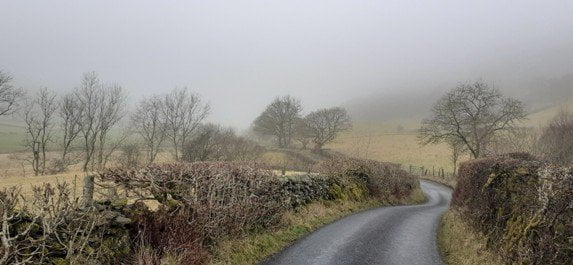
Visiting the Lakes recently, I planned to follow in the prodigious footsteps of brother and sister Dorothy and William Wordsworth. Prodigious, because the two of them (and others of their family and entourage) were astonishing perambulators, who turned walking into an artform. Walking, particularly arduous walking, had for centuries been a solely practical business, as well as a dangerous one (highwaymen and footpads might lurk at any corner). Walking for its own sake involved a new mindset. Both walked tens of thousands of miles in their lifetime, not so much mindless of distance, weather and terrain as rejoicing what they could accomplish under any conditions, across distances no regular town-dweller could contemplate. They knew they were extraordinary. Here is Dorothy, describing one such journey on 7 December 1801, covering the dozen miles or so from Grasmere to Keswick in around four hours (the Raise is an 883m fell in the Helvellyn range):
We rose by candlelight. A showery unpleasant morning, after a downright rainy night. We determined, however, to go to Keswick if possible, and we set off a little after 9 o’clock. When we were upon the Raise, it snowed very much; and the whole prospect closed in upon us, like a moorland valley, upon a moor very wild. But when we were at the top of the Raise we saw the mountains before us. The sun shone upon them, here and there; and Wytheburn vale, though wild, looked soft. The day went on cheerfully and pleasantly. Now and then a hail shower attacked us; but we kept up a good heart, for Mary [William Wordsworth’s wife] is a famous jockey… We reached Greta Hall at about one o’clock.
It was art as much as it was exercise (of freedom). The exultation Dorothy expresses so ably in her journals at how they journeyed out expresses a sense of poetic discovery, the complement to brother William’s reinvention of poetic language and sensibility. The same exultation imbued both.
The Wordsworths, were they to return to the Lakes today, once they had got over the shock of seeing streets, houses, hotels, cakes, tea towels and posters named after them, would be able to follow the routes along which they had trod, and all the generations before them, succeeding each other in procession through time. But they would be shocked beyond all measure at the new roads created to facilitate tourism. Side-by-side with each picturesque valley is a modern road, humming with traffic ultimately led here by the Wordsworths and their circle, who had turned that which had previously seemed fearsome to outsiders into the Romantic and thence touristic.
The roads that carry visitors into the heart of the Lakes are ingeniously done. While not exactly hidden, they occupy spaces away from the dream, never featuring in the travel sites, guidebooks, posters, photographs, jigsaws and artworks that sustain the reverie. The Lake District is a delicately-arranged organism, transporting us where we wish to go while sustaining the ideal of a place unsullied by such ugly necessities.
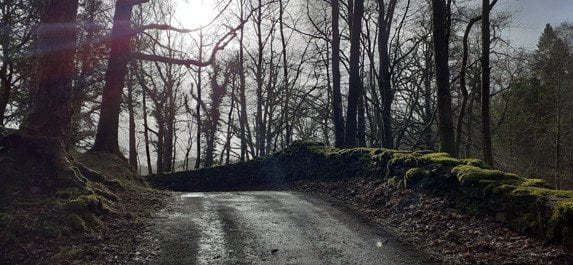
I feel something of a personal association, almost a sense of guilt, at these encroachments on the Romantic. I happen to live in the former home of the man who helped make it happen. Thomas Aveling is not a familiar name compared to his Victorian engineering peers such as Brunel and Stephenson, but he could be argued to have been one of the most influential inventors of all time. Aveling invented the steam roller, or road roller.
Aveling was a farmer and engineer. Based first at Hoo, he would move to Rochester, eventually serving as its mayor. The story goes that he was exasperated at the sight of an engine being transported by a team of horses, when he knew that the engine itself had the potential power to do the dragging itself. Teaming up with Richard Thomas Porter, he first developed the traction engine in its recognisable form in 1859, then the steam roller in 1867. Aveling and Porter, as their firm was named, went on to become the world’s largest producer and exporter of steam rollers. Combined with Edgar Purnell Hooley’s 1902 invention of Tarmacadam, there were in place the technologies needed to produce reliable and durable roads that could be built at an industrial scale, literally laying the way for the motor cars that would then pour onto them in profusion. From vision to capability to application. And so the world changed.
Now we drive round the same routes, one after another, in an endless procession that starts in modern times and will persist for as long as we feel compelled to journey somewhere. They belong to that same bird’s-eye-view of that fundamental human need to keep moving, to be always going somewhere.
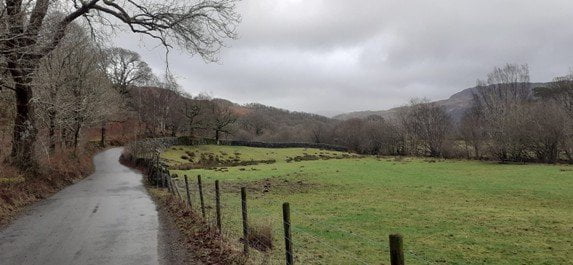
What is the particular relevance of this to the Lake District? The area had become the place of poetry thanks to the Lake poets, and the modern road is a part of that poetry. The Wordsworths walked along roads (significantly improved, even in their day, from what they had once been) quite as much as they walked along paths and fell tracks. Rebecca Solnit, in her book Wanderlust: A History of Walking, notes this but draws a distinction between the roads then and those now:
Though Wordsworth is in some sense the founding father (and therefore Dorothy the aunt) of a modern taste that has done much to shape the more pleasant parts of our world and the imaginations of those in it, he himself was heir to a long tradition, and so it is more accurate to see him as a transformer, a fulcrum, a catalyst for the history of walking in the landscape. His precursors, it is true, had not much walked on the public roads (and for the most part, neither do his modern descendants, since cars have made roads dangerous and miserable again) … In fact, walking had already become an important activity, though not as travel. Few of Wordsworth’s pedestrian antecedents are to be found travelling along the public roads, but many of them were strolling in gardens and parks.
But it is not always so miserable to walk along the roads of the Lake District. Frequently it is a necessity, as permitted paths cannot be everywhere, and often the road is the best route to follow if you need to be going somewhere. Of course, a muddy path along a fellside or a weaving woodland track have romance; a B-road passing through a valley, on the face of it, does not. But the views are the same, the skies are the same, the weather is the same, the physical experience is much the same, the encouragement to reverie should be the same. I have walked many miles down Lake District roads, grateful for the reliable surface, keeping always to the right-hand side of those many roads where no side path exist, so that oncoming cars can see you. I treasure those graceful moments where, along some narrow road, I have to step aside and stand still by a strip of hedgerow to let a car go past, and there is the briefest sign of acknowledgment from the driver, a lifting of a hand in thanks and shared understanding. We both know the journey we are on.
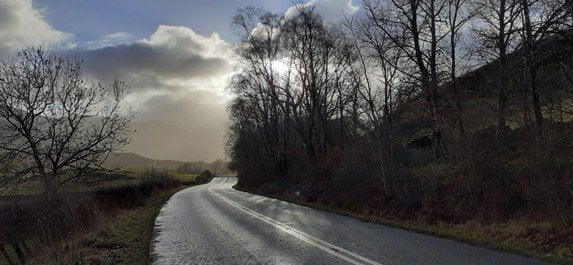
Also to be treasured is the road itself, and where it takes you. William Wordsworth writes of roads in The Prelude (1805 version):
I love a public road: few sights there are
That please me more – such object hath had a power
O’er my imagination since the dawn
Of childhood, when its disappearing line
Seen daily afar off, on one bare steep
Beyond the limited which my feet had trod, was like a guide into eternity,
At least to things unknown and without bound
That’s the quality of any road, any path ultimately – the sense of leading us on endlessly, because the goal is beyond and we are there for the journey. But the Lakeland location matters because it was the home of a new poetic vision, one centred on the relationship between the human and the natural, one that inspired the intimations of immortality in the young Wordsworth and, by implication, everyone. The childhood vision enshrined in The Prelude and ‘Ode: Intimations of Immortality’ is part of a journey down a road whose end we do not see, because journeying is all.
Wordsworth came to loathe the modernity his vision of things ushered in. Certainly he loathed the tourists and the technologies of transportation that brought them to enjoy but thereby spoil the Lakeland idyll. Nevertheless, he could recognise their function in sustaining the vision, as he grants in his late poem (composed 1833) ‘Steamboats, Viaducts, and Railways’:
Motions and means, on land and sea at war
With old poetic feeling: not for this
Shall ye, by poets even, be judged amiss.
Nor shall your presence, howsoe’er it mar
The loveliness of Nature, prove a bar
To the mind’s gaining that prophetic sense
Of future change, that point of vision whence
May be discovered what in soul ye are.
In spite of all that beauty may disown
In your harsh features, Nature doth embrace
Her lawful offspring in man’s art, and Time,
Pleased with your triumphs o’er his brother Space,
Accepts from your bold hands the proffered crown
Of hope, and smiles on you with cheer sublime.
There is nothing more poetic than a road. Petering into the distance (“its disappearing line”), eventually lost by a curve or dip in the land, it expresses the anticipation and uncertainty of any journey. It tells us that we are all travellers, and that travelling is what makes us alive. That our age has been so proficient at making roads, often joyless wide strips rolled remorselessly flat, that nullify the landscape through which they cut, should not blind us to a creation fundamental to human understanding. We build roads so everyone may share the journey. I might prefer to stroll along the B5322 as it winds through St John’s in the Vale than trudge along the verge of the M2 (I have done both), but they share the same quality. Both are hopeful; both may lead us to the sublime.
Links:
- The Journals of Dorothy Wordsworth vol. 1 (featuring her Grasmere journals) is available on Project Gutenberg
- Kathleen Jones’s A Passionate Sisterhood: Women of the Wordsworth Circle (2000) is a very fine account of Dorothy Wordsworth, Mary Wordsworth, Sarah Coleridge, Edith Southey, Dora Wordsworth and others
- Alan Cleaver and Lesley Park’s The Corpse Roads of Cumbria: Walks Along the County’s Ancient Paths (2018) is a delightful, practical guide to following what remains these paths
- For a definitive study of steam rollers, traction engines and Thomas Aveling, see James Preston, Aveling & Porter: An Illustrated History (2019)
- A number of Lakeland roads follow the lines of those built by the Romans, documented in the Cumbrian section of The Roman Roads of Britain site